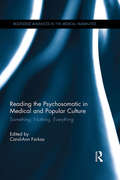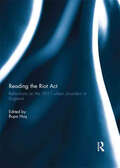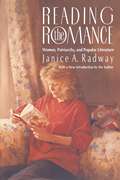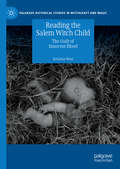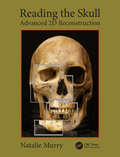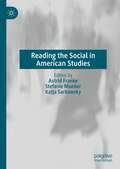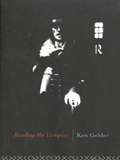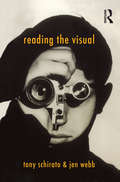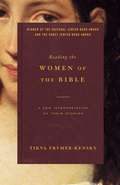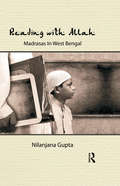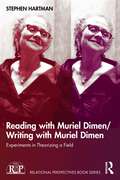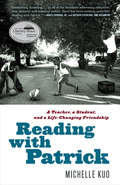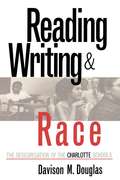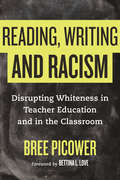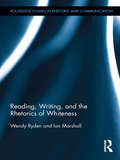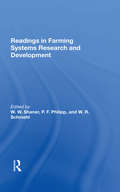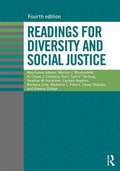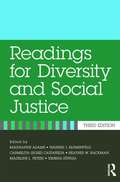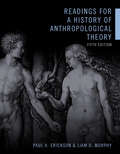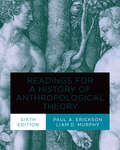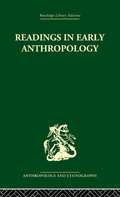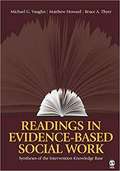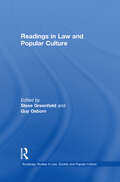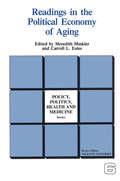- Table View
- List View
Reading the Psychosomatic in Medical and Popular Culture: Something. Nothing. Everything (Routledge Advances in the Medical Humanities)
by Carol-Ann FarkasPain. Chronic digestive symptoms. Poor sleep. Neuropathy. Sensory disturbances. Fatigue. Panic. Constant illness and discomfort. Frequent difficulty coping with work, school, relationships. Despite the common experience of being told that it’s all in their heads, that they’re just making themselves sick, individuals with these symptoms are experiencing a very real, sometimes debilitating, illness phenomenon. But what is it? Physical or mental illness? Political or social identity? Cultural, narrative, or discursive construction? When something goes awry at the intersection of mind and body – the psychosomatic – what is happening? Widely recognized, yet difficult to classify, diagnose, treat, and explain, psychosomatic disorders are heavily stigmatized, and the associated syndromes have become the site of controversy and antipathy in the provider–patient relationship. In popular culture, terms such as medically unexplained symptoms, hysteria, neurasthenia, hypochondria, functional illness, and malingering are misunderstood, unknown, or rejected outright. Meanwhile, perspectives from cultural and textual studies focus on the psychosomatic as a metaphor in art, literature, and popular media, where disruptions of the body and mind are regularly made to stand in for individual alienation and cultural malaise. Bringing together multiple perspectives, this challenging volume tackles causes, and innovative, humanistic solutions, to conflicts in the provider–patient relationship; uses the psychosomatic as a lens for theorizing the self in culture; and examines the metaphorical potential of the psychosomatic in fictional narrative. Providing a unique assemblage of interdisciplinary, international approaches to understanding the problem of the psychosomatic in both expert and lay discourses, this pioneering edited collection is aimed at students and researchers of health, popular culture, and the health care humanities.
Reading the Riot Act: Reflections on the 2011 urban disorders in England
by Rupa HuqThis lively collection presents a multi-disciplinary, multi-perspectival commentary explaining the what, where, and how of the riots that the austerity-hit UK experienced during the long, hot summer of 2011. It looks beyond London and its Tottenham district where disturbances started, to locations such as Manchester and Birmingham. Parallels are drawn with Cairo during the period of the Arab spring, and even with the Star Wars saga. The book locates the riots in historical context by looking at the previous UK riots of 1981 and 2001, looking at how news cycles and concepts such as that of ‘moral panic’ have changed in the age of social networking. It is essential reading for anyone interested in contemporary debates in social policy, media studies, anthropology sociology, cultural studies, and human geography. This book was originally published as a special issue of the Journal for Cultural Research.
Reading the Romance
by Janice A. RadwayOriginally published in 1984, Reading the Romance challenges popular (and often demeaning) myths about why romantic fiction, one of publishing's most lucrative categories, captivates millions of women readers. Among those who have disparaged romance reading are feminists, literary critics, and theorists of mass culture. They claim that romances enforce the woman reader's dependence on men and acceptance of the repressive ideology purveyed by popular culture. Radway questions such claims, arguing that critical attention "must shift from the text itself, taken in isolation, to the complex social event of reading." She examines that event, from the complicated business of publishing and distribution to the individual reader's engagement with the text.Radway's provocative approach combines reader-response criticism with anthropology and feminist psychology. Asking readers themselves to explore their reading motives, habits, and rewards, she conducted interviews in a midwestern town with forty-two romance readers whom she met through Dorothy Evans, a chain bookstore employee who has earned a reputation as an expert on romantic fiction. Evans defends her customers' choice of entertainment; reading romances, she tells Radway, is no more harmful than watching sports on television."We read books so we won't cry" is the poignant explanation one woman offers for her reading habit. Indeed, Radway found that while the women she studied devote themselves to nurturing their families, these wives and mothers receive insufficient devotion or nurturance in return. In romances the women find not only escape from the demanding and often tiresome routines of their lives but also a hero who supplies the tenderness and admiring attention that they have learned not to expect.The heroines admired by Radway's group defy the expected stereotypes; they are strong, independent, and intelligent. That such characters often find themselves to be victims of male aggression and almost always resign themselves to accepting conventional roles in life has less to do, Radway argues, with the women readers' fantasies and choices than with their need to deal with a fear of masculine dominance.These romance readers resent not only the limited choices in their own lives but the patronizing atitude that men especially express toward their reading tastes. In fact, women read romances both to protest and to escape temporarily the narrowly defined role prescribed for them by a patriarchal culture. Paradoxically, the books that they read make conventional roles for women seem desirable. It is this complex relationship between culture, text, and woman reader that Radway urges feminists to address. Romance readers, she argues, should be encouraged to deliver their protests in the arena of actual social relations rather than to act them out in the solitude of the imagination.In a new introduction, Janice Radway places the book within the context of current scholarship and offers both an explanation and critique of the study's limitations.
Reading the Salem Witch Child: The Guilt of Innocent Blood (Palgrave Historical Studies in Witchcraft and Magic)
by Kristina WestThis book discusses the role of children in the Salem witch trials through a close reading of the many and varied narratives of the trials, including court records, contemporary and historical documents, fiction, drama, and poetry. Taking a critical theory approach to explore both what we might understand as a child in 1692 New England and to consider our adult investment in reading the child, Kristina West explores narratives of the afflicted girls and the many accused children whom are often absent or overlooked in histories, and considers how the trial structure is continually repeated in attempts to establish the respective guilt and innocence of these and other groups. This book also analyses later manuscripts and fictional rewritings of the trials to question the basis on which assumptions about the child in history are made, and to consider why such narratives of Salem’s children are still relevant now.
Reading the Skull: Advanced 2D Reconstruction
by Natalie MurryWhile there are a handful of introductory texts and resources on 2D drawing for facial identification and reconstruction, most often they don’t go beyond this cursory presentation of the subject. There is need for an advanced text available for artists who wish to learn more about reading and understanding the skull to inform more accurate and detailed 2D craniofacial reconstruction work. Reading the Skull: Advanced 2D Reconstruction fills this need by providing instruction on how to identify basic features, as well as indicators and anomalies in bone structures, to help in illustrating more specific and unique details in facial structure and features. Since artists are most frequently visual learners, the book presents comparative photos of skulls with life photos to help better identify and decipher distinguishing facial characteristics. Because many forensic artists perform few reconstructions each year— and have very little exposure to skulls— the author has written this text to show examples of distinct elements in the skull for artists to see, compare, and learn. In doing so, it provides those who do not regularly work with skulls more exposure to them and allows readers the ability to apply such information and better extrapolate features for the purpose of more accurately rendering an individual’s unique facial features. When examining the skull closely, each feature can be more detailed based on what the bone is indicating, and the work can be more accurate to that specific skull. Characteristics such as the ears, facial harmony and symmetry, shape of eye and brow, nose and mouth, the aging process, sex and ancestral background— among others— are all singular to that skull and adds to the gestalt of that face to make it more identifiable as an individual. Reading the Skull is a ground- breaking collection of the author’s personal study and research, other published works from the literature on facial features, as well as numerous examples from donors to forensic anthropology centers in the US. Work presented draws upon new information from anthropologists and others in related fields and disciplines who continue to study facial features based on the skull. As such, it provides a fresh perspective, summarizing several studies and work together in a single book. Natalie Murry is a freelance forensic artist currently based in Austin, Texas. She began her forensic art career while working as a police officer in Kent Washington. She does reconstructions and postmortem drawings for the King County Medical Examiner’s Office in Seattle Washington, and the Snohomish County Medical Examiner’s Office in Everett Washington. She has taught forensic artists to draw digitally at workshops at police departments from Washington to New Jersey as well as at Scottsdale Artists School and at the Forensic Anthropology Center at Texas State University. Natalie is on the forensic art subcommittee for the International Association for Identification, and is an IAI certified forensic artist. She has had two articles published in the Journal of Forensic Identification: in September/ October 2015 entitled “Rotating the Anterior View of a Skull into the Frankfort Horizontal Plane for Postmortem Drawings” and in April/ June 2021 entitled “Skull to Photo Comparison for Identification Purposes.” She has been a beta tester for Corel Painter since the 2016 build. Her work can be seen on her website, www.natal iemu rry.com, on Instagram as @NatalieMurryForensicArt, and on Facebook as NatalieMurryForensicArt.
Reading the Social in American Studies
by Katja Sarkowsky Astrid Franke Stefanie MuellerReading the Social in American Studies offers a unique exploration of the advantages and benefits in using sociological terms and concepts in American literary and cultural studies and, conversely, in using literature—understood broadly—to uncover a microlevel of the social. Its temporal scope ranges from the early 19th to the 21st century, providing a historical dimension that is otherwise often missing from studies on the conjunction of literature and sociology. The contributors’ approaches include genre reflections as well as close readings, theoretical discussions of crucial sociological terms, and literary observations backed up by empirical sociological studies. The book will familiarize international readers with ideas on the social from both sides of the Atlantic, including scholarship of such figures as John Dewey, Georg Simmel, Norbert Elias, and Pierre Bourdieu.
Reading the Vampire (Popular Fictions Series)
by Ken GelderInsatiable bloodlust, dangerous sexualities, the horror of the undead, uncharted Trannsylvanian wildernesses, and a morbid fascination with the `other': the legend of the vampire continues to haunt popular imagination.Reading the Vampire examines the vampire in all its various manifestations and cultural meanings. Ken Gelder investigates vampire narratives in literature and in film, from early vampire stories like Sheridan Le Fanu's `lesbian vampire' tale Carmilla and Bram Stoker's Dracula, the most famous vampire narrative of all, to contemporary American vampire blockbusters by Stephen King and others, the vampire chronicles of Anne Rice, `post-Ceausescu' vampire narratives, and films such as FW Murnau's Nosferatu and Bram Stoker's Dracula.Reading the Vampire embeds vampires in their cultural contexts, showing vampire narratives feeding off the anxieties and fascinations of their times: from the nineteenth century perils of tourism, issues of colonialism and national identity, and obsessions with sex and death, to the `queer' identity of the vampire or current vampiric metaphors for dangerous exchanges of bodily fluids and AIDS.
Reading the Visual
by Tony Schirato Jen WebbFrom the body to the ever-present lens, the world is increasingly preoccupied with the visual. What exactly is the visual' and how can we interpret the multitude of images that bombard us every day? Reading the Visual takes as its starting point a tacit familiarity with the visual, and shows how we see even ordinary objects through the frameworks and filters of culture and personal experience. It explains how to analyse the mechanisms, conventions, contexts and uses of the visual in western cultures to make sense of visual objects of all kinds. Drawing on a range of theorists including John Berger, Foucault, Bourdieu and Crary, the authors outline our relationship to the visual, tracing changes to literacies, genres and pleasures affecting ways of seeing from the Enlightenment to the advent of virtual technology.Reading the Visual is an invaluable introduction to visual culture for readers across the humanities and social sciences. Eloquently written, admirably clear, passionately argued, Schirato and Webb have given us one of the best textbooks on the emergent field of visual culture. Smart, clear and relevant examples challenge readers to question their visual environments and become critics and creators themselves.' Professor Sean Cubitt, University of Waikato This is a splendid book. It is both intellectually sophisticated and written in an extremely accessible manner.' Professor Jim McGuigan, Loughborough University This book treats the interpretation and value of visual artefacts with depth, while remaining highly accessible. It is very readable: written in a lively and engaging style with examples that are refreshing and up-to-date.'Professor Guy Julier, Leeds Metropolitan University
Reading the Women of the Bible: A New Interpretation of Their Stories
by Tikva Frymer-KenskyReading the Women of the Bible takes up two of the most significant intellectual and religious issues of our day: the experiences of women in a patriarchal society and the relevance of the Bible to modern life.
Reading the past: Current approaches to interpretation in archaeology
by Ian Hodder Scott HutsonThe third edition of this classic introduction to archaeological theory and method has been fully updated to address the rapid development of theoretical debate throughout the discipline. Ian Hodder and Scott Hutson argue that archaeologists must consider a variety of perspectives in the complex and uncertain task of "translating the meaning of past texts into their own contemporary language". While remaining centered on the importance of meaning, agency and history, the authors explore the latest developments in post-structuralism, neo-evolutionary theory and phenomenology. Previous Edition Hb (1991): 0-521-40142-9 Previous Edition Pb (1991): 0-521-40957-8
Reading with Allah: Madrasas in West Bengal
by Nilanjana GuptaBased on extensive fieldwork and archival records, this book traces the emergence and flourishing of madrasas and the myriad ways in which they impact upon local Muslim communities, especially in West Bengal. It also addresses issues of identity, ‘secular’ education and gender in this context, while exploring the myths that surround these institutions. Amongst other things, it interrogates why Muslim communities prefer sending their sons to government schools to receive a secular education, while the daughters are sent to madrasas.
Reading with Muriel Dimen/Writing with Muriel Dimen: Experiments in Theorizing a Field (Relational Perspectives Book Series)
by Stephen HartmanReading with Muriel Dimen/Writing with Muriel Dimen: Experiments in Theorizing a Field is a collection of reading and writing experiments inspired by the late feminist psychoanalyst Muriel Dimen. Each of the six projects that comprise this volume explores a stylistic and thematic manner of reading and responding to Dimen’s work, challenging the field to write outside the standardized edition, and covering a remarkable breadth of essential analytic topics, such as sex, gender, money, love and hate, and boundary violations. As an homage to Dimen’s quest to engage the personal and the political in the author’s craft, and in collaboration with Dimen’s endeavour to foster revolution across the psychosocial landscape that renders psychoanalysis its field, the authors offer readers a wild analysis of reading and writing. Providing a clear introduction to and exploration of Muriel Dimen’s groundbreaking work, this book will prove essential for scholars of psychoanalysis, cultural studies, and gender studies, as well as anyone seeking to understand Dimen’s influence on psychoanalytic practice today.
Reading with Patrick: A Teacher, A Student And A Life-changing Friendship
by Michelle KuoA memoir of race, inequality, and the power of literature told through the life-changing friendship between an idealistic young teacher and her gifted student, jailed for murder in the Mississippi Delta Recently graduated from Harvard University, Michelle Kuo arrived in the rural town of Helena, Arkansas, as a Teach for America volunteer, bursting with optimism and drive. But she soon encountered the jarring realities of life in one of the poorest counties in America, still disabled by the legacy of slavery and Jim Crow. In this stirring memoir, Kuo, the child of Taiwanese immigrants, shares the story of her complicated but rewarding mentorship of one student, Patrick Browning, and his remarkable literary and personal awakening. Convinced she can make a difference in the lives of her teenaged students, Michelle Kuo puts her heart into her work, using quiet reading time and guided writing to foster a sense of self in students left behind by a broken school system. Though Michelle loses some students to truancy and even gun violence, she is inspired by some such as Patrick. Fifteen and in the eighth grade, Patrick begins to thrive under Michelle’s exacting attention. However, after two years of teaching, Michelle feels pressure from her parents and the draw of opportunities outside the Delta and leaves Arkansas to attend law school. Then, on the eve of her law-school graduation, Michelle learns that Patrick has been jailed for murder. Feeling that she left the Delta prematurely and determined to fix her mistake, Michelle returns to Helena and resumes Patrick’s education—even as he sits in a jail cell awaiting trial. Every day for the next seven months they pore over classic novels, poems, and works of history. Little by little, Patrick grows into a confident, expressive writer and a dedicated reader galvanized by the works of Frederick Douglass, James Baldwin, Walt Whitman, W. S. Merwin, and others. In her time reading with Patrick, Michelle is herself transformed, contending with the legacy of racism and the questions of what constitutes a “good” life and what the privileged owe to those with bleaker prospects. Reading with Patrick is an inspirational story of friendship, a coming-of-age story of both a young teacher and a student, a deeply resonant meditation on education, race, and justice in the rural South, and a love letter to literature and its power to transcend social barriers.Advance praise for Reading with Patrick“This book is special and could not be more right on time. It’s an absorbing, tender, and surprisingly honest examination of race and privilege in America that helps articulate what is often lost, seemingly intentionally, in national debates over criminal justice and education: the inner life and imagination of a young person.”—Wes Moore, author of The Other Wes Moore “Every American should read Michelle Kuo’s remarkable memoir. Honest, generous, humble, and wise, Reading with Patrick will endure as a defining story for our times and, abidingly, a testament to the power of language and of books.”—Claire Messud, author of The Woman Upstairs“I delighted in this book and read it in a single weekend. Reading with Patrick is a significant work that could swell the ranks of highly motivated and qualified teachers—people who understand they are not just transferring information but transforming lives.”—Bill Moyers “Riveting . . . an essential addition to our national conversation about institutional racism.”—Elliott Holt, author of You Are One of Them
Reading, Writing and Race
by Davison M. DouglasUsing Charlotte, North Carolina, as a case study of the dynamics of racial change in the 'moderate' South, Davison Douglas analyzes the desegregation of the city's public schools from the Supreme Court's 1954 Brown v. Board of Education decision through the early 1970s, when the city embarked upon the most ambitious school busing plan in the nation. In charting the path of racial change, Douglas considers the relative efficacy of the black community's use of public demonstrations and litigation to force desegregation. He also evaluates the role of the city's white business community, which was concerned with preserving Charlotte's image as a racially moderate city, in facilitating racial gains. Charlotte's white leadership, anxious to avoid economically damaging racial conflict, engaged in early but decidedly token integration in the late 1950s and early 1960s in response to the black community's public protest and litigation efforts. The insistence in the late 1960s on widespread busing, however, posed integration demands of an entirely different magnitude. As Douglas shows, the city's white leaders initially resisted the call for busing but eventually relented because they recognized the importance of a stable school system to the city's continued prosperity.
Reading, Writing, and Racism: Disrupting Whiteness in Teacher Education and in the Classroom
by Bree PicowerAn examination of how curriculum choices can perpetuate White supremacy, and radical strategies for how schools and teacher education programs can disrupt and transform racism in educationWhen racist curriculum "goes viral" on social media, it is typically dismissed as an isolated incident from a "bad" teacher. Educator Bree Picower, however, holds that racist curriculum isn't an anomaly. It's a systemic problem that reflects how Whiteness is embedded and reproduced in education. In Reading, Writing, and Racism, Picower argues that White teachers must reframe their understanding about race in order to advance racial justice and that this must begin in teacher education programs.Drawing on her experience teaching and developing a program that prepares teachers to focus on social justice and antiracism, Picower demonstrates how teachers' ideology of race, consciously or unconsciously, shapes how they teach race in the classroom. She also examines current examples of racist curricula that have gone viral to demonstrate how Whiteness is entrenched in schools and how this reinforces racial hierarchies in the younger generation.With a focus on institutional strategies, Picower shows how racial justice can be built into programs across the teacher education pipeline--from admission to induction. By examining the who, what, why, and how of racial justice teacher education, she provides radical possibilities for transforming how teachers think about, and teach about, race in their classrooms.
Reading, Writing, and the Rhetorics of Whiteness (Routledge Studies in Rhetoric and Communication)
by Ian Marshall Wendy RydenIn this volume, Ryden and Marshall bring together the field of composition and rhetoric with critical whiteness studies to show that in our "post race" era whiteness and racism not only survive but actually thrive in higher education. As they examine the effects of racism on contemporary literacy practices and the rhetoric by which white privilege maintains and reproduces itself, Ryden and Marshall consider topics ranging from the emotional investment in whiteness to the role of personal narrative in reconstituting racist identities to critiques of the foundational premises of writing programs steeped in repudiation of despised discourses. Marshall and Ryden alternate chapters to sustain a multi-layered dialogue that traces the rhetorical complexities and contradictions of teaching English and writing in a university setting. Their lived experiences as faculty and administrators serve to underscore the complex code of whiteness even as they push to decode it and demonstrate how their own pedagogical practices are raced and racialized in multiple ways. Collectively, the essays ask instructors and administrators to consider more carefully the pernicious nature of whiteness in their professional activities and how it informs our practices.
Readings In Farming Systems Research And Development
by W. R. Schmehl W R Schmehl Perry F Philipp W. W. ShanerThis collection offers a comprehensive view of the commonalities and diversities of the farming systems research and development (FSR&D) approaches being applied around the world. The authors–among the leading practitioners in FSR&D–discuss conceptual frameworks, research methodology, data collection, and several ongoing FSR&D programs. The book is a must for anyone interested in gaining a concise, yet broad view of this new and growing field of research and its importance to small-scale farming in developing countries.
Readings for Diversity and Social Justice
by Heather W. Hackman Madeline L. Peters Ximena Zuniga Barbara J. Love D. Chase J. Catalano Larissa E. Hopkins Davey Shlasko Maurianne Adams Warren J. Blumenfeld Keri DeJongCurrent topics and events such as the Black Lives Matter movement, workplace immigration raids, gentrification, wealth inequality, the disability rights of prisoners and inmates, and the Keystone XL pipeline protests, additional resources and short classroom-friendly videos that further complement the readings in each section.A holistic approach to sexism, gay, lesbian, trans and gender-queer oppression that challenges widely-held assumptions about the usual practice of separating analyses of sex and gender binaries. A more optimistic focus on the role of social justice at all levels of society, whether personal, institutional local, or global, and the intersections among them.
Readings for Diversity and Social Justice (Third Edition)
by Maurianne Adams Warren Blumenfeld Carmelita Castaneda Heather W. Hackman Madeline L. Peters Ximena ZunigaFor more than a decade, Readings for Diversity and Social Justice has been the trusted, leading anthology to cover the full range of social oppressions from a social justice standpoint. With full sections dedicated to racism, sexism, classism, heterosexism, and ableism, as well as transgender oppression, religious oppression, and adult and ageism, this bestselling text goes far beyond the range of traditional readers. New essay selections in each section of this third edition have been carefully chosen to keep topic coverage timely and readings accessible and engaging for students. The interactions among these topics are highlighted throughout to stress the interconnections among oppressions in everyday life. Retaining the key features and organization that has made Readings for Diversity and Social Justice an indispensable text for teaching issues of social justice while simultaneously updating and expanding its coverage, this new edition features: Over 20 new selections considering current topics and events such as immigration trends, racial profiling, student debt, Occupy Wall Street and global GLBT rights. An updated companion website with additional resources, including video clips that further complement the readings in each section. Strong and accessible section introductions to highlight key points and relate the essential concepts of any given topic to other forms of oppression. An explicit emphasis on the interconnectedness of social identity and social inequality throughout, with a second table of contents that notes the intersections among readings. Offering over one-hundred and thirty selections from some of the foremost scholars in a wide range of fields, Readings for Diversity and Social Justice is the indispensible volume for every student, teacher, and social justice advocate.
Readings for a History of Anthropological Theory, Fifth Edition
by Paul A. Erickson Liam D. MurphyThe fifth edition of this bestselling reader builds a strong foundation in both classical and contemporary theory, with a sharpened focus on gender and anthropology, and the anthropology of new media and technology. Short introductions and key terms accompany every reading, and light annotations have been added to aid students in reading original articles. Used on its own or together with A History of Anthropological Theory, Fifth Edition, this anthology offers a flexible and unrivalled introduction to anthropological theory that reflects not only the history but also the changing nature of the discipline today.
Readings for a History of Anthropological Theory, Sixth Edition
by Paul A. Erickson, Liam D. MurphyReadings for a History of Anthropological Theory curates and collects many of the most important publications of anthropological thought spanning the last hundred years, building a strong foundation in both classical and contemporary theory. The sixth edition includes seventeen new readings, with a sharpened focus on public anthropology, gender and sexuality, race and ethnicity, linguistic anthropology, archaeology, and the Anthropocene. Each piece of writing is accompanied by a short introduction, key terms, study questions, and further readings that elucidate the original text. On its own or together with A History of Anthropological Theory, sixth edition, this anthology offers an unrivalled introduction to the theory of anthropology that reflects not only its history but also the changing nature of the discipline today.
Readings in Early Anthropology
by James S. SlotkinThis book considers the beginnings of anthropology as a cultural tradition, and examines how it was developed and transmitted. It begins in the twelfth century, when commercial capitalism and extensive acculturation spread a secular world view among intellectuals. It ends with the eighteenth century, because most anthropologists are familiar with the subsequent history of their science. Originally published in 1963.
Readings in Evidence-based Social Work: Syntheses of the Intervention Knowledge Base
by Bruce A. Thyer Michael G. Vaughn Matthew O. HowardExposing readers to "what works" across a wide range of practice domains, Readings in Evidence-Based Social Work meets a growing need within schools of social work to incorporate the latest research on evidence-based practice into the curriculum. This one-of-a-kind reader synthesizes current knowledge, adds editorial commentary and questions, and presents state-of-the-art material to help students better understand which social work interventions work and why.
Readings in Law and Popular Culture (Routledge Studies in Law, Society and Popular Culture)
by Guy Osborn Steven GreenfieldReadings in Law and Popular Culture is the first book to bring together high quality research, with an emphasis on context, from key researchers working at the cutting-edge of both law and cultural disciplines. Fascinating and varied, the volume crosses many boundaries, dealing with areas as diverse as football-based computer games, Buffy the Vampire Slayer, digital sampling in the music industry, the films of Sidney Lumet, football hooliganism, and Enid Blyton. These topics are linked together through the key thread of the role of, or the absence of, law - therefore providing a snapshot of significant work in the burgeoning field of law and popular culture. Including important theoretical and truly innovative, relevant material, this contemporary text will enliven and inform a legal audience, and will also appeal to a much broader readership of people interested in this highly topical area.
Readings in the Political Economy of Aging (Policy, Politics, Health and Medicine Series)
by Meredith Minkler Carroll L EstesIncludes 16 essays which address many issues from a different perspective suggested by the experience of aging in America. This study explores the political, social, and economic realities which have an impact on Americans as they grow older.
